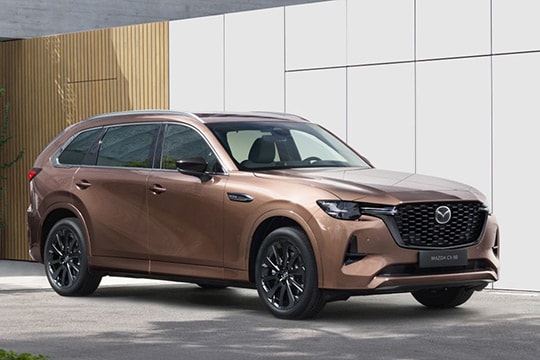MAZDA CX-80 Models/Series Timeline, Specifications & Photos
First production year: 2024
Engines: Plug-in hybrid, Mild hybrid diesel
Body style: SUV (Sports Utility Vehicle)
Mazda unveiled the CX-80 in the spring of 2024 as its European flagship SUV, although customers had to wait until the fall of the same year for the three-row vehicle to be in their driveways.
While all the other main Japanese automakers already had a premium brand in their portfolios, Mazda adopted a different strategy. Instead of creating a new company under its roof, it tried to evolve and became an upscale car manufacturer. The entire transformation began in 2022 when it released the CX-60. After that, the Japanese brand launched the CX-90 for the North American market, and all three shared the same platform. Even though, at first sight, the CX-80 and the CX-90 seemed to look identical, there were some differences between them.
At the front, the CX-80 featured a large pentagonal grille adorned by piano black or chromed trims that surrounded it and was flanked by organic-looking LED headlights. Underneath them, the automaker placed a set of side scoops. On the lower part of the bumper, Mazda also created a slim horizontal air intake, which helped to cool the engine. The car manufacturer considered that it wasn’t necessary to add fog lamps and spoil the look of the vehicle with them.
From its profile, the long hood and the cab-rearward design of the CX-80 emphasized the rear-wheel-drive-biased platform of the SUV. A set of fake vents adorned the front fenders and sported the “inline 6” wording on them. Mazda offered its European flagship crossover in a choice of five grades: Exclusive-line, Homura, Takumi, Homura Plus, and Takumi Plus. In addition, customers could opt for a few packages, depending on the grade. A large panoramic sunroof was also available. Furthermore, the CX-80 was the first Mazda to sport retractable sunshades on the rear doors in the European market. Out back, the crossover had a raked-forward tailgate, which was available with a foot-gesture opening system. Its L-shaped taillights were already specific for the carmaker’s large SUVs. Finally, the rear bumper neatly concealed the exhausts, and the automaker didn’t install fake ones.
With a cabin fit for up to seven passengers (eight for the CX-90), the CX-80 tried to compete against other full-size European crossovers. Mazda also offered an option for a six-seat version, depending on the grade, with captain seats in the middle row. At the front, drivers faced an elegantly designed dashboard adorned by hand-stitched decorations and fabric upholstery. Atop the center stack, the automaker installed a 12.3-inch touchscreen. At the same time, the driver fronted a TFT display inside the instrument cluster, which looked identical to the one from the CX-90. All versions featured AC vents for all three rows and plenty of USB ports for everybody onboard the vehicle. Furthermore, the PHEV version was available with a 1500 W AC power outlet in the trunk.
Mazda offered the CX-80 with a choice of two powertrains. The gasoline-powered PHEV version featured an inline-four, naturally aspirated engine, which was helped by an electric motor to propel the large crossover. The system’s total output reached 327 PS (322 hp). Thanks to its battery pack, the car could travel on electricity alone for up to 60 km (37 miles), usually enough for a round trip to work and back. The other option was a mild-hybrid system powered by a 3.3-liter inline-six turbodiesel helped by an electric motor for a combined power of 254 PS (251 hp). Both versions sent their oomph in all corners via an eight-speed automatic transmission.
